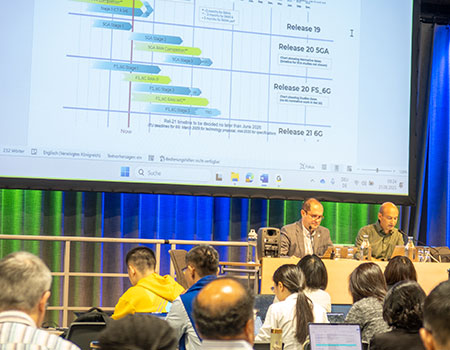By Shyam Gadhai and Rohit Budhiraja, TSDSI Member - IIT Kanpur
First published May 2023, in Highlights Issue 06
As we move towards higher operating frequencies, i.e., mmWave in the new radio (NR) standard, and towards THz frequency range for 6G, network coverage issues will become severe. To improve coverage, different network nodes e.g., Integrated Access Backhaul (IAB), radio frequency (RF) repeaters, network-controlled repeaters (NCR) have been proposed in the standard. These nodes not only enhance the coverage, but also improve the end user throughput.
The IAB node, which was introduced in NR Release 16, is essentially a decode-and-forward relay with functionality up to Layer-2. Its wireless backhaul and access link are integrated to operate in a similar frequency range.
The IAB architecture is based on the centralized unit/distributed unit (CU/DU) split of the 5G base station (gNB), which is shown in Figure 1. An IAB node includes an MT (“mobile terminal”) unit, and a DU unit. The MT unit connects to the DU of the parent node as a normal user equipment (UE). The DU has up to Layer-2 functionality, and acts as a decode-and-forward unit for UEs. An IAB node, therefore, has its own physical layer cell-id, and it is not transparent to a UE. Further enhancements to support simultaneous transmission and reception in IAB were introduced in Release 17.

Figure 1: IAB node architecture (TR 38.874)
Another network node known as NCR was introduced in Release-18. It is a smarter version of the conventional amplify-and-forward RF repeater, which does not have any intelligence. The NCR is also an amplify-and-forward repeater, but with an additional capacity of beamforming towards UEs, manage downlink and uplink transmissions, switch itself on and off, based on the side-control information received from the gNB.

Figure 2: System model of Network-controlled repeater (source: 3GPP TR 38.867)
The NCR, as shown in Figure 2, consists of:
1) NCR-MT unit, which is similar to the IAB-MT unit. It connects to its parent gNB as a normal device, and identifies itself as an NCR to the network. It also decodes control information for forwarding; and
2) NCR-Fwd unit, which is its amplify-and-forward unit. It consists of only an RF layer, and thus does not decode any data intended to/from a user. NCR is, thus, a device which is more capable than the conventional RF repeater, but lesser capable than an IAB.
The NCR, when compared with an IAB, only decodes control information applicable to NCR. It does not decode any control/data/signal intended for UE. It thus has a lower cost than IAB. Also, it does not have its own physical layer cell ID, and hence is transparent to a UE. The release-18 NCR is envisaged only as a stationary single-hop device support. Further enhancements to NCR may be possible in Release-19.
The intelligent reflective surfaces (IRS), as a network node, has gained significant attention recently. When compared with a repeater, it does not amplify the signal, but only forwards it. More specifically, it is a smart reflecting device which can help in controlling the channel by reflecting the signal in the desired direction. It does so by applying appropriate phase-shifts to the received signal. Different IRS architectures have been investigated in literature, and can have active and/or passive antenna elements. However, from 3GPP standardization point of view, as the IABs and NCRs already have active antenna elements, and IRS being envisaged as a very low cost and energy efficient device, it is more likely to have only passive elements. However, this configuration can also be a part of study when IRS is introduced as a study item or work item (SI/WI) in 3GPP. Figure 3 shows the basic difference between NCR and IRS. When compared with NCR and IAB, IRS may not have a MT unit, but rather a simple controller unit, which may be connected using either a wired or wireless backhaul. Also, it does not have two antenna panels for Rx and Tx, but a single panel for reflection.

Figure 3: Difference between NCR and IRS
IRS is not yet a study item in 3GPP, more discussion is expected prior to Rel-19. Some of the important proposals for its study would be:
- Use case /Deployment scenario: Study of use cases and scenarios where IRS will fit in. A major use case of IRS being envisaged is that of improving the network throughput by providing a strong non-line-of-sight (NLOS) path in blockage scenario.
- Signalling protocol: Define signalling between parent nodes and IRS controller to indicate control information such as beam weights.
- Channel Modeling: IRS is envisaged as a reconfigurable cluster in a channel model. The existing 38.901 channel model needs to be studied. This will also include the size of IRS for practical deployment scenarios, and the study of near-field/far-field radio propagation characteristics.
- Impact on existing procedures: Impact of IRS on existing procedures such as initial attach, beam management, radio link/ beam failure recovery, interference mitigation also needs to be studied.
With all these network nodes being standardized in 3GPP, future wireless networks are envisaged to have a hybrid combination of gNBs and IABs, which make up the macro and small cells, and NCR and IRS enhancing the coverage and connectivity to the UE, and thus forming a ubiquitous intelligent and connected network. Such an intelligent network will become essential to enable future applications of integrated sensing and communication, ultra-high precise positioning, and augmented and virtual reality applications.


 Partners News
Partners News 




